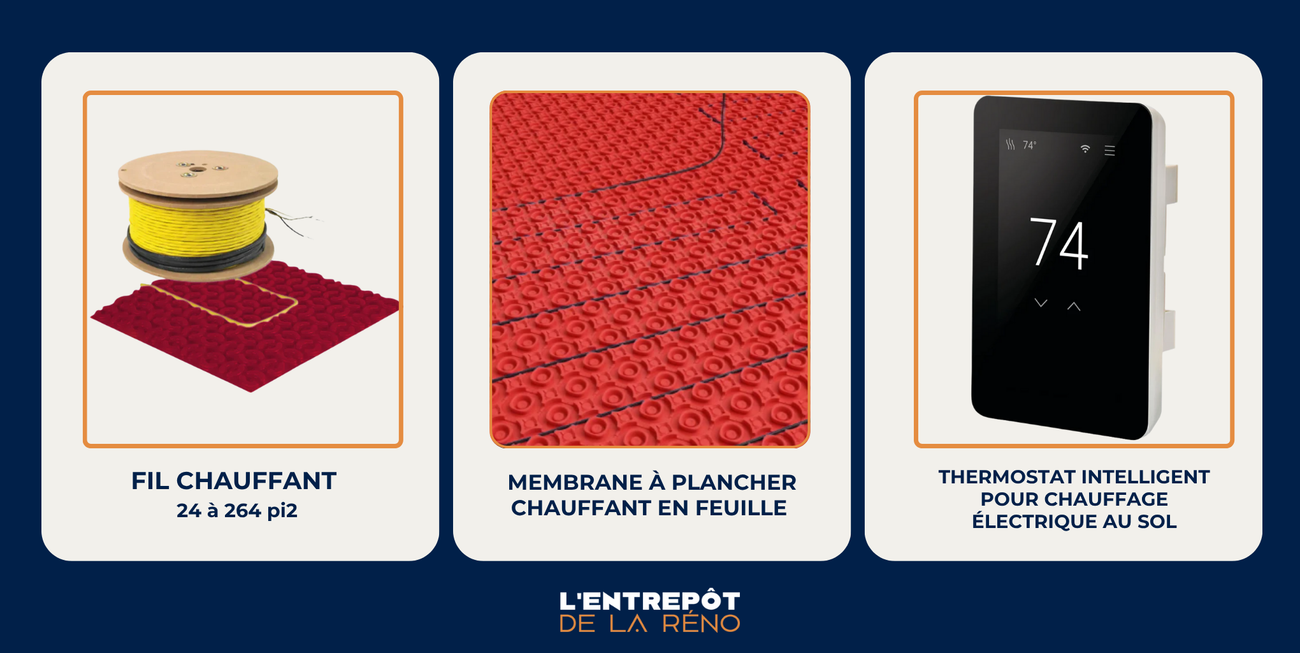Electric underfloor heating: comprehensive answers to your most frequently asked questions

Why choose electric underfloor heating?
Electric radiant heating provides gentle and even warmth, reduces dust by eliminating air convection, and can even lower your energy bills when the room is well insulated. However, before you start, certain questions keep coming up. Here are our answers, based on industry best practices and our field expertise.
1. What happens if a heating wire is cut?
- No fire risk: the cut simply interrupts the circuit, and the cable stops heating.
- Loss of heated surface: the area powered by this wire will no longer produce heat.
- Possible repairs: there are repair kits to re-solder and insulate the damaged section. A qualified electrician can safely restore the cable to service.
- Renovation Warehouse Tip: always test the continuity of the cables with an ohmmeter before pouring the screed or laying the tiles.
2. Is a heated floor enough to heat the entire room?
Yes, in the majority of cases. A well-sized system typically reaches 12 to 15 W/ft² – ample enough to heat a bathroom, kitchen, or well-insulated bedroom.
For large areas or poorly insulated rooms, our team can calculate the necessary power and recommend the right cable or mat.
3. Schluter®-DITRA-HEAT membrane or our in-house membrane?
- DITRA-HEAT: excellent 2-in-1 solution (uncoupling + heating). It manages substrate movement, ensures waterproofing, and accepts dedicated Schluter® cables.
- Our radiant membrane: same main functions, but with tighter studs for a more even installation. Result: better thermal uniformity.
- Availability: we stock our own membrane to ensure competitive prices, quick availability, and perfect compatibility with our cables.
4. Why are our prices so competitive?
We buy in bulk, develop our own brand, and eliminate intermediaries. This allows us to offer one of the best value-for-money ratios on the market.
5. What covering to install on a heated floor?
- Ceramic, porcelain, or stone: ideal – their thermal conductivity is excellent, allowing heat to diffuse quickly.
- Wood effect tiles: the perfect compromise between a warm look and thermal performance.
- Vinyl, laminate, or compatible floating floors: possible, but less responsive. The maximum temperature recommended by the manufacturer must be respected.
6. Who should connect the system to the power supply?
- Mechanical installation: you can lay the membrane and unroll the cables yourself by following the instructions.
- Electrical connection: must be made by a certified electrician, in accordance with the Canadian Electrical Code. The circuit must be protected by a ground fault circuit interrupter (GFCI) and controlled by an approved thermostat.
- Warranty: our manufacturer's warranty is only valid if the final connection is made by a qualified professional.
7. Should materials be checked before and after the work?
- Before: ensure that the substrate is flat, clean, and well insulated.
- During: check the ohmic resistance of the cable at each stage with an ohmmeter.
- After: measure the final resistance and perform a power-on test. If necessary, a surface test will detect any anomalies or damaged cables.
Need personalized advice?
Contact the Reno Warehouse team : we calculate your project, guide you on the choice of cable, membrane, and covering, and connect you with a certified electrician if necessary.
- A cut wire simply blocks the current; repairable by a pro.
- Properly sized radiant heating is sufficient to heat the room.
- Our membrane ensures uniform warmth and remains more affordable.
- Ceramic (or our wood effect tiles) maximizes performance.
- The connection must be made by an electrician to comply with the code and the warranty.
Transform your floor into a source of comfort – sustainably and at the best price.
